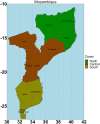Climate variability, socio-economic conditions and vulnerability to malaria infections in Mozambique 2016-2018: a spatial temporal analysis
- PMID: 37325319
- PMCID: PMC10267345
- DOI: 10.3389/fpubh.2023.1162535
Climate variability, socio-economic conditions and vulnerability to malaria infections in Mozambique 2016-2018: a spatial temporal analysis
Abstract
Background: Temperature, precipitation, relative humidity (RH), and Normalized Different Vegetation Index (NDVI), influence malaria transmission dynamics. However, an understanding of interactions between socioeconomic indicators, environmental factors and malaria incidence can help design interventions to alleviate the high burden of malaria infections on vulnerable populations. Our study thus aimed to investigate the socioeconomic and climatological factors influencing spatial and temporal variability of malaria infections in Mozambique.
Methods: We used monthly malaria cases from 2016 to 2018 at the district level. We developed an hierarchical spatial-temporal model in a Bayesian framework. Monthly malaria cases were assumed to follow a negative binomial distribution. We used integrated nested Laplace approximation (INLA) in R for Bayesian inference and distributed lag nonlinear modeling (DLNM) framework to explore exposure-response relationships between climate variables and risk of malaria infection in Mozambique, while adjusting for socioeconomic factors.
Results: A total of 19,948,295 malaria cases were reported between 2016 and 2018 in Mozambique. Malaria risk increased with higher monthly mean temperatures between 20 and 29°C, at mean temperature of 25°C, the risk of malaria was 3.45 times higher (RR 3.45 [95%CI: 2.37-5.03]). Malaria risk was greatest for NDVI above 0.22. The risk of malaria was 1.34 times higher (1.34 [1.01-1.79]) at monthly RH of 55%. Malaria risk reduced by 26.1%, for total monthly precipitation of 480 mm (0.739 [95%CI: 0.61-0.90]) at lag 2 months, while for lower total monthly precipitation of 10 mm, the risk of malaria was 1.87 times higher (1.87 [1.30-2.69]). After adjusting for climate variables, having lower level of education significantly increased malaria risk (1.034 [1.014-1.054]) and having electricity (0.979 [0.967-0.992]) and sharing toilet facilities (0.957 [0.924-0.991]) significantly reduced malaria risk.
Conclusion: Our current study identified lag patterns and association between climate variables and malaria incidence in Mozambique. Extremes in climate variables were associated with an increased risk of malaria transmission, peaks in transmission were varied. Our findings provide insights for designing early warning, prevention, and control strategies to minimize seasonal malaria surges and associated infections in Mozambique a region where Malaria causes substantial burden from illness and deaths.
Keywords: Bayesian; DHS; DLNM; INLA; Mozambique; climate variability; malaria vulnerability; spatio-temporal.
Copyright © 2023 Armando, Rocklöv, Sidat, Tozan, Mavume, Bunker and Sewes.
Conflict of interest statement
The authors declare that the research was conducted in the absence of any commercial or financial relationships that could be construed as a potential conflict of interest.
Figures




Similar articles
-
Spatial-temporal analysis of climate and socioeconomic conditions on cholera incidence in Mozambique from 2000 to 2018: an ecological longitudinal retrospective study.BMJ Open. 2024 Aug 19;14(8):e082503. doi: 10.1136/bmjopen-2023-082503. BMJ Open. 2024. PMID: 39160100 Free PMC article.
-
Spatio-temporal modelling and prediction of malaria incidence in Mozambique using climatic indicators from 2001 to 2018.Sci Rep. 2025 Apr 8;15(1):11971. doi: 10.1038/s41598-025-97072-6. Sci Rep. 2025. PMID: 40200072 Free PMC article.
-
Spatial and temporal patterns of malaria incidence in Mozambique.Malar J. 2011 Jul 13;10:189. doi: 10.1186/1475-2875-10-189. Malar J. 2011. PMID: 21752284 Free PMC article.
-
Bayesian spatio-temporal modelling of environmental, climatic, and socio-economic influences on malaria in Central Vietnam.Malar J. 2024 Aug 24;23(1):258. doi: 10.1186/s12936-024-05074-y. Malar J. 2024. PMID: 39182127 Free PMC article.
-
Environmental and geographical factors influence malaria transmission in KwaZulu-Natal province, South Africa.Geospat Health. 2025 Jan 23;20(1). doi: 10.4081/gh.2025.1370. Epub 2025 Jun 9. Geospat Health. 2025. PMID: 40491412
Cited by
-
Spatial-temporal analysis of climate and socioeconomic conditions on cholera incidence in Mozambique from 2000 to 2018: an ecological longitudinal retrospective study.BMJ Open. 2024 Aug 19;14(8):e082503. doi: 10.1136/bmjopen-2023-082503. BMJ Open. 2024. PMID: 39160100 Free PMC article.
-
Bayesian spatio-temporal modeling and prediction of malaria cases in Tanzania mainland (2016-2023): unveiling associations with climate and intervention factors.Int J Health Geogr. 2025 Aug 1;24(1):20. doi: 10.1186/s12942-025-00408-8. Int J Health Geogr. 2025. PMID: 40750887 Free PMC article.
-
Field testing of user-friendly perennial malaria chemoprevention packaging in Benin, Côte d'Ivoire and Mozambique.Malar J. 2024 May 21;23(1):157. doi: 10.1186/s12936-024-04977-0. Malar J. 2024. PMID: 38773567 Free PMC article.
-
Potential impact of climatic factors on malaria in Rwanda between 2012 and 2021: a time-series analysis.Malar J. 2024 Sep 10;23(1):274. doi: 10.1186/s12936-024-05097-5. Malar J. 2024. PMID: 39256741 Free PMC article.
-
Impact of heat on mental health emergency visits: a time series study from all public emergency centres, in Curitiba, Brazil.BMJ Open. 2023 Dec 22;13(12):e079049. doi: 10.1136/bmjopen-2023-079049. BMJ Open. 2023. PMID: 38135317 Free PMC article.
References
-
- World Health Organization . World malaria report 2020: 20 years of global progress and challenges. (2020) 299.
Publication types
MeSH terms
LinkOut - more resources
Full Text Sources
Medical

